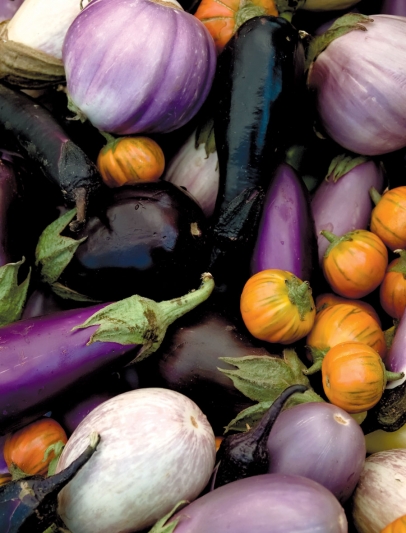Eggplants—Tasting East and West
I saw my first eggplant in the ninth grade when my art teacher brought several into the classroom and composed a still life for us to render in pastels. I was entranced by the eggplants’ rich, deep purple color and glossy sheen and I desperately tried to capture these on the slightly pebbled gray paper we were handed.
What I produced wasn’t bad, but it wasn’t great either. Yet I’ve never forgotten that first sight and introduction to the fruit (yes, botanically the eggplant is a fruit, not a vegetable).
Our teacher, who was well-traveled, explained to the class that eggplant was popular in Greek and Italian dishes, such as moussaka and eggplant Parmesan, neither of which I had ever eaten, and that it also belonged to the nightshade or Solanaceae family, which also included datura, belladonna and deadly nightshade, all poisonous. I found it all extremely exotic and enticing.
Moussaka, I later discovered, is a Greek classic, layering eggplant and lamb (and sometimes potatoes, also in the nightshade family) with an egg-enriched béchamel sauce. I didn’t actually taste this sumptuous and satisfying dish until I traveled to Greece in my 20s, but I ordered eggplant Parmesan the first time I saw it in on a menu when I was still in high school, and it has remained a lifelong favorite.
For me, though, it is the French dish known as ratatouille that best captures the essence of eggplant. In that iconic vegetable stew of Provence, eggplant is combined with zucchini, peppers, onions, garlic and tomatoes and cooked in plenty of olive oil and seasoned with the wild herbs of Provence.
In the ensuing years since that first introduction, I have learned that eggplant was introduced into the Mediterranean region by the Moors as early as in the eighth century, but it took centuries before the once considered “deadly” fruit was accepted as safe to eat. Even its Italian name, melanzana, from mala insana, translated as “mad apple,” indicates the fear with which eggplants were initially regarded. It’s not surprising then to learn that eggplants were originally cultivated in Europe primarily as exotic ornamentals.
In South Asia and East Asia, however, where eggplants originated, the fruit has long been highly regarded both for taste and texture and as a cure for multiple illnesses.
Today we refer to eggplants as either European or Asian. European varieties are mostly round or oval, with some elongated cultivars, while Asian eggplants are predominantly long and thin, some up to 1 1/2 feet long, but they can be as small as an inch or so in diameter, ranging in color from bright, almost fluorescent, lavender to nearly black, as well as green and white. These can be used interchangeably with the European types, but have fewer seeds and thinner skins. The Asian varieties also include the golf-ball-size, green and white striated Thai eggplants.
In Indian cooking, eggplants are commonly used in curries, such as Baingan Bharta, a north Indian curry where the eggplant is fire-roasted, the skin discarded, and the flesh combined with tomatoes, spices and other ingredients. There are numerous Thai and other Southeast Asian dishes that include eggplants, and eggplants are also a common component in Chinese and Japanese dishes where they often appear grilled or stir-fried—an excellent treatment for European eggplants as well.
The European types of eggplants come in a variety of colors and sizes also. Some are the size of a grapefruit, while others might reach the size of a melon. Some are smooth, others lobed. They may be purple, lavender, striated lavender and white, entirely white, or blushed with a pinkish lavender, as well as white.
Among cooks, there always seems to be a controversy over whether or not to salt and drain eggplant before cooking and why—or why not. Salting the sliced or cubed eggplant does draw out some of the moisture and, after wiping off the liquid that rises to the surface, the eggplant browns a little more quickly and will absorb less oil when fried. Sometimes— rarely—eggplant may be bitter, and this salting process is said to ameliorate any bitterness.
What do I think? During the years following my adolescent introduction to eggplant, I’ve grown a half dozen or more different varieties, and cooked hundreds of different eggplant dishes. I’ve salted a few times and found it to be an extra step that provided no real difference in flavor. Thus, I hew to the skip-the-salting side of the controversy.
Even though eggplants are now available year round, they are in their prime in summer, and preserving them in olive oil and vinegar is a great way to enjoy them during the rest of the year, as well.
Georgeanne Brennan is the author of more than 30 cookbooks and garden books. She lives in Winters, California, where she writes, cooks and runs her new business, La Vie Rustic. LaVieRustic.com










